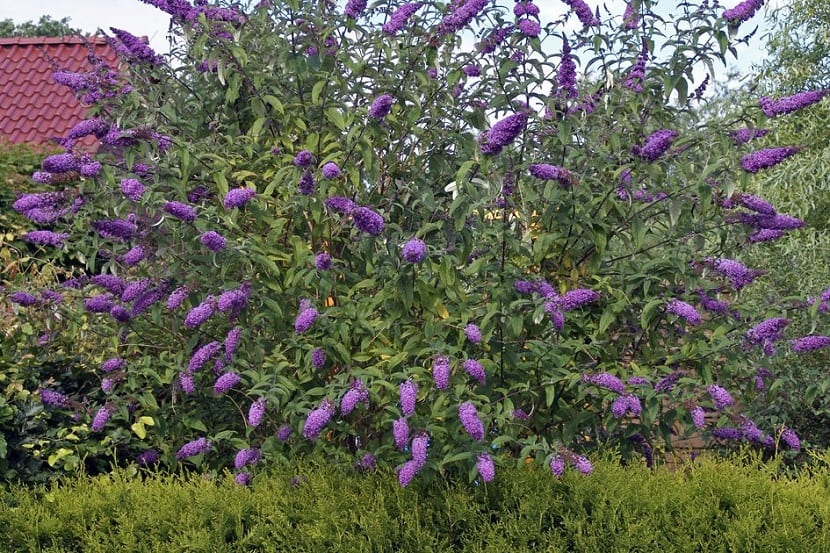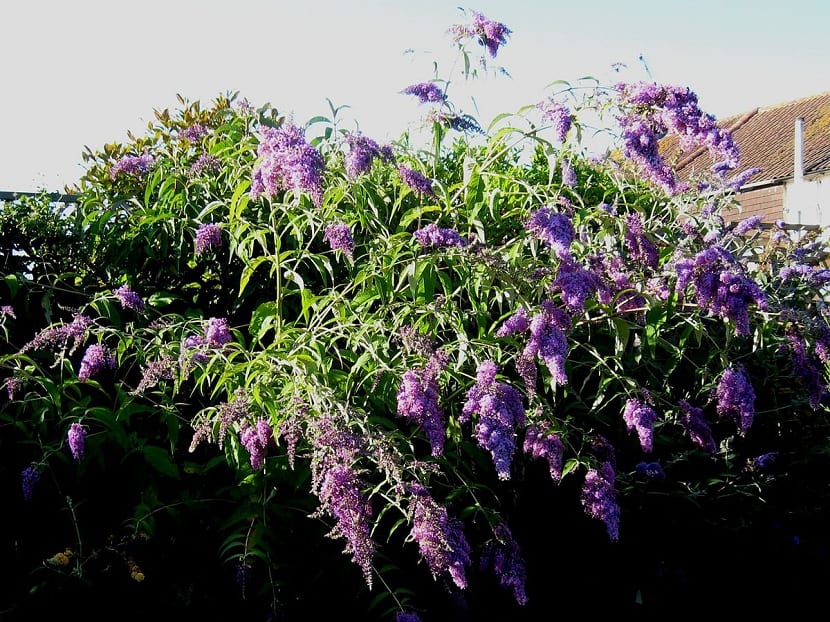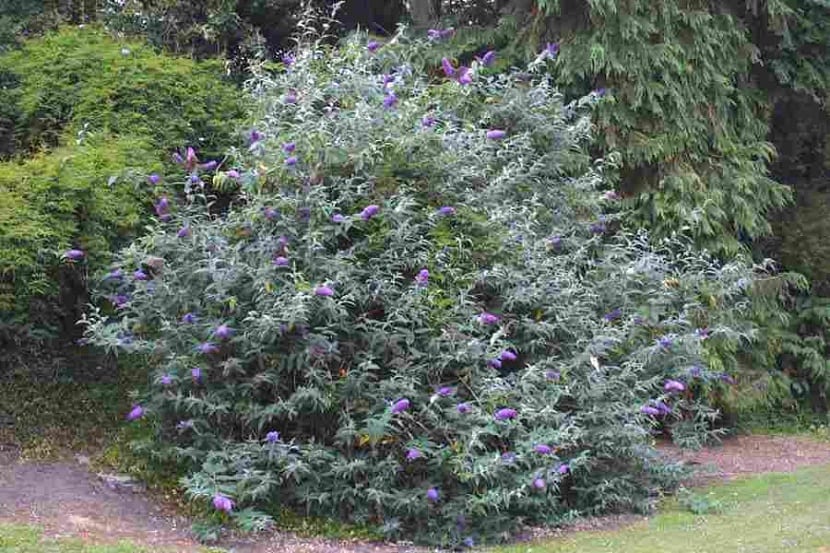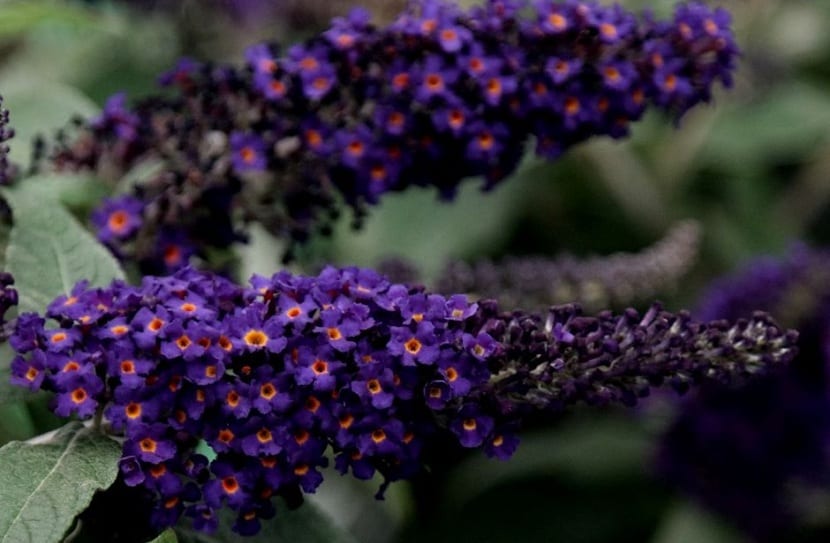
Today we are going to talk about a well-known shrub for garden decoration whose origin comes from Japan and China. It is the butterfly bush. Its scientific name is Buddleja davidii and it is known by other common names such as budelia, budleja, butterfly flower and summer lilo. It is widely used in all the gardens of the world for being quite resistant.
In this post you will be able to know all the characteristics and care of the Buddleja davidii.
Key features

It is a bush capable of reaching up to two meters in height in good condition. It has a deciduous or semi-deciduous leaf depending on the climate where it is found. They are normally quite resistant to frost and other more unfavorable environmental conditions.
It has branches of the arched type and with a hanging aspect. The leaves have an elongated shape and are green in color, ending in a point. There are varieties of leaves that have a green to gray color. This is what makes him look stormy. The winter temperature usually affects the conservation of the leaves. If the temperatures are generally lower, it will cause you to lose more leaves until you run out of them. Being branched, it will have a lot of density and will be a perfect shrub to cover some things that you do not want to see or provide more privacy to your garden.
Its flowers form beautiful clusters of lilac or pink color and make its decorative power greater. They also have a pleasant aroma that will further characterize the area where you grow it. One of the common names is summer lilac, since its lilac summer flowering brings very good sensations with it that are mixed with the unique aroma.
Another reason why it is called a butterfly bush is because this aroma we are talking about is capable of attracting a multitude of butterflies of all kinds. You can have a large number of pollinating insects that will help the rest of the plants in your garden to reproduce better.
It is capable of growing so rapidly that in many countries it is considered an invasive plant. You have to be careful with some native plants because they can displace them.
Requirements of Buddleja davidii

This shrub can provide great benefits to the garden such as attracting pollinating insects, a pleasant aroma and a very beautiful color. However, it takes a few requirements for it to thrive. One of them is that they require a spacious place. As we have mentioned before, it is a quite branched shrub and, therefore, if it has adequate growth and favorable environmental conditions, it can grow to more than 3 meters in height.
Being so branched it will take up a lot of space in the garden. If we want to take advantage of all its shrub size, we must have enough space so that the branches are not obstructed or limited in their growth and development.
The flowering time is in summer. It needs higher temperatures to be able to flower well, since in winter it is weaker and ends up losing almost all its leaves. The most suitable climate necessary for it to prosper without any problem is the Mediterranean. This is because it is mainly characterized by hotter, drier summers and mild, wet winters. If the temperatures are lower in winter, they will suffer a lot. They are usually resistant to several frosts, but if they are too frequent, they will suffer.
They are resistant to coastal areas where the air carries more salt particles.
Necessary care

It is a bush whose care is really easy and is used to form groups within the garden or use them as isolated specimens. If they are grouped, they will be able to attract more pollinating insects such as bees and butterflies.
So that your needs are on the surface, full sun exposure is required. It can also thrive in semi-shade, but it is the best for winter. In the semi-shade there are usually lower temperatures and this affects the development of the leaves and their increase in the fall of the same. If the winter is quite cold or there are unexpected frosts, it can be protected with a plastic.
As for the ground, it can thrive in calcareous soils as long as they contain an acceptable amount of organic matter. If at the beginning of its growth you have planted it in a not too optimal area, if you want to transplant it again in its final place, it will have to be done in spring.
Irrigation will have to be abundant and more frequent in the warm months spring and summer. The rest of the year will be quite shortened. The only important indicator to keep in mind in winter is that the soil does not dry out completely. Only then is it necessary to water. The most normal thing is that with the winter rainfall they are more than enough.
Maintenance and reproduction

To maintain its ideal conditions throughout the year, the most convenient thing is to pay it once a year. You have to use an organic fertilizer as can be manure or compost and you can add it when it is time to use the annual fertilizer for the entire garden. In this way we will not get too complicated in this part.
Regarding maintenance tasks, it is advisable to prune them intensively when autumn arrives. As soon as the flowers begin to fall and disappear, it is necessary to prune it enough so that, during the winter, it can be strengthened until it blooms much stronger the following year.
If you do not control the humidity well and it exceeds what is recommended, it may be attacked by aphids and other viral diseases.
To multiply them, the most advisable thing is to use cuttings. It must be done in the autumn or spring time and place them in a chest of drawers with glass so that they can root well. It is best done in spring since the temperatures are higher and they do not have to withstand the cold of winter. Physiologically it is easier for them to prosper in the warm season.
I hope that with these tips you can enjoy the Buddleja davidii in your garden.
Thank you
Thanks to you, Montse.